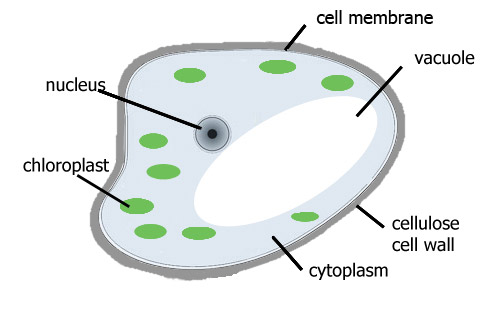Plant Cells
The building blocks
of all plant life from tiny flowers to giant forests
Basics
All living organisms are made of cells, loads and loads of them. Typically plant cells are in the micrometer range, being around 10 - 100 micrometers (or microns) in one of their dimensions (this is very variable however). A micrometer is a millionth of a meter or a thousandth of a millimeter, it would take about 2,500 to cover a full stop (period) like this one .
Two of the most commonly encountered groups of organisms are animals and plants, while these are made of cells that have many things in common, they also have a few fundamental characteristic things that are different.

A simple animal cell

A simple plant cell
All cells have a cell membrane around them, this is very important, far more than you might think, it controls what enters and leaves the cell. Inside the cell is the nucleus, this contains the DNA of the cell and controls what the cell does. The rest of the cell is filled with the cytoplasm, this is mainly made of water but is quite a thick liquid, it is where the chemical reactions of the cell take place.
Seen down a simple microscope, there are three extra structures in a plant cell that you don't find in animal cells. Surrounding the cell is a strong cell wall made of a tough substance called cellulose. This wall is not waterproof however, the membrane lining it keeps the water in. The wall is like the tyre on a wheel with the membrane being the inner tube, or if you prefer, the outside of a ball with the membrane being the bladder. Inside the cell is a large structure called the vacuole, this is surrounded by its own membrane. This can fill with water to "inflate" the cell without affecting the cytoplasm, it also gets used to dump cellular "rubbish" in or often holds unpleasant (or even tasty, to us) chemicals to deter herbivores, especially insects. Cells from the above ground parts of the plant will often contain chloroplasts, especially if they are in the leaves, chloroplasts contain the pigment chlorophyll which plants use to make food in the process of photosynthesis.
From the pictures above, it might seem that plant cells are more complicated than animal cells, they aren't really, you can just see more of what is in them using a simple microscope.
More about plant cells
Like animal cells, plant cells are full of organelles, the "little organs" of the cell that have specific tasks in the cell.

- Cell membrane - a fluid barrier that contains the cell and controls what leaves and enters.
- Nucleus - contains the DNA, the genetic material of the cell, controls the cell and carries the blueprint of the whole organism.
- Chloroplast - present in most parts of the plant that are exposed to light, these contain the green pigment chlorophyll that carries out photosynthesis to make food for the plant, for obvious reasons these are most concentrated in the cells of the leaves. The chloroplasts often contain starch grains which is how the glucose initially made from glucose is stored.
- Cell wall - made of a substance called cellulose, this provides a tough outer barrier for the cell, it also provides much of what we refer to as roughage or fibre in our food.
- Membrane bound vesicle - there are a number of these in the cytoplasm containing all manner of packaged biochemicals, the membranes they are made of are very similar to the cell membrane.
- Vacuole - a large membrane bound sac in the cell that contains a whole range of chemicals, many of them such as tannins and alkaloids provide defence for the plant if it is eaten by herbivores. Waste chemicals are also deposited here to be removed from the plant when it drops its leaves.
- Cytoplasm - a watery jelly - like liquid mainly water, where many reactions of the cell take place.
- Mitochondrion - where respiration takes place, this being the process that releases energy from food. The power plants of the cell. Mitochondria - plural.
- Ribosome - these are responsible for making proteins using information from the DNA in the nucleus and raw materials in the cytoplasm.
- Endoplasmic reticulum (ER) - the "test tubes and beakers" of the cell, where chemical reactions take place without contacting other parts of the cell or cytoplasm. It may be rough endoplasmic reticulum, RER or smooth, SER. The rough is made that way by ribosomes attached to the outside. The ER is made of the same material as the cell membrane.
- Golgi apparatus - a specialized part of the endoplasmic reticulum that modifies proteins after they have been made packaging them in bags of membrane for transport within the cell or secretion out of the cell.






